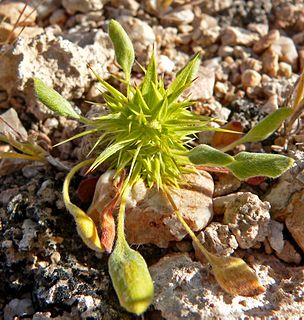
Chorizanthe is a genus of plants in the buckwheat family known generally as spineflowers. These are small, squat, herbaceous plants with spiny-looking inflorescences of flowers. The flowers may be in shades of red or yellow to white. The bracts are pointed and sometimes tipped with a hooked awn, and the inflorescence often dries into a rounded, spiny husk. Spineflowers are found in western North America and South America.
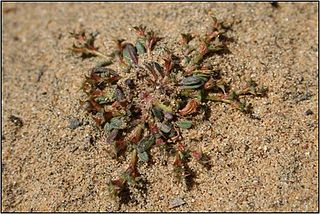
Chorizanthe orcuttiana is a rare small annual plant in the buckwheat family, Polygonaceae. It is known commonly as Orcutt's spineflower or the San Diego spineflower, and it is endemic to San Diego County, California. The plant is diminutive, and a hand-lens is necessary for proper identification. The plant is very sensitive to temperature and precipitation, and under drought or hot conditions the seeds will not germinate or survive. The plant is visible anywhere from February through July during good rain year, but most years the plant is only visible from April to June. Each minute flower yields one seed.

Chorizanthe parryi is a species of flowering plant in the buckwheat family known by the common name Parry's spineflower and San Bernardino spineflower.
Chorizanthe angustifolia is a species of flowering plant in the buckwheat family known by the common name narrowleaf spineflower.
Chorizanthe biloba is a species of flowering plant in the buckwheat family known by the common name twolobe spineflower. It is endemic to California, where it is known only from the Central Coast Ranges. There are two varieties, both of which are uncommon to rare.
Chorizanthe blakleyi is a rare species of flowering plant in the buckwheat family known by the common name Blakley's spineflower. It is endemic to the Sierra Madre Mountains of Santa Barbara County, California, where it is known from only eight occurrences, four of which are within the bounds of the Los Padres National Forest. It grows only on north-facing slopes in chaparral and woodland habitat. This plant grows upright to no more than 15 centimeters tall. It is yellow-green and hairy, with a few basal leaves up to about 2 centimeters long. The inflorescence contains several flowers, each surrounded by a tube of six hairy bracts with straight or hooked awns. The flower is a few millimeters wide with white or pink deeply notched tepals.
Chorizanthe breweri is a rare species of flowering plant in the buckwheat family known by the common names San Luis Obispo spineflower and Brewer's spineflower. It is endemic to California, where it is known from about twenty occurrences in the Central Coast Ranges of San Luis Obispo and far southern Monterey Counties. It grows in the chaparral and woodlands of the range, generally on serpentine soils. This small plant produces decumbent stems extending along the ground and sometimes growing upright to a maximum length of about half a meter. The herbage is mostly reddish in color and somewhat hairy. The inflorescence is a cluster of flowers, each surrounded by six hairy reddish bracts with hooked tips. The flower itself is only about 3 millimeters wide and is white to red and hairy.

Chorizanthe corrugata is a species of flowering plant in the buckwheat family known by the common name wrinkled spineflower. It is native to the Mojave and Sonoran Deserts of the southwestern United States and two states of northwest Mexico, Baja California and Sonora.

Chorizanthe cuspidata is a species of flowering plant in the buckwheat family known by the common name San Francisco spineflower. It is endemic to California, where it is known only from the San Francisco Bay Area and to the immediate north and south. It grows in sandy coastal habitat.

Chorizanthe douglasii is a species of flowering plant in the buckwheat family known by the common names San Benito spineflower and Douglas' spineflower. It is endemic to California, where it grows in the mountains of the Southern California Coast Ranges, from the Santa Lucia Range east to the Gabilan Range.
Chorizanthe howellii is a species of flowering plant in the buckwheat family known by the common names Mendocino spineflower and Howell's spineflower. It is endemic to coastal Mendocino County, California, where it is known only from the sand dunes and coastal scrub near Fort Bragg. It is estimated that 95% of the remaining individuals of this plant are part of a single population growing at MacKerricher State Park. It is a federally listed endangered species.
Chorizanthe leptotheca is a species of flowering plant in the buckwheat family known by the common names Ramona spineflower and Peninsular spineflower. It is native to the Peninsular Ranges of southern California and Baja California, where it grows in chaparral and forest habitat. It is very similar to its close relative, Turkish rugging.
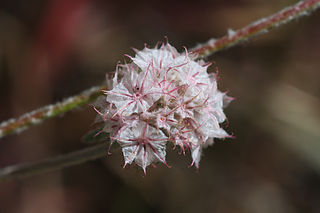
Chorizanthe membranacea is a species of flowering plant in the buckwheat family known by the common name pink spineflower. It is native to Oregon and California, where it is widespread and in some areas quite common. It can be found in a wide variety of habitats.
Chorizanthe obovata is a species of flowering plant in the buckwheat family known by the common name spoonsepal spineflower. It is endemic to California, where it grows in the mountains of the Central Coast Range from Monterey to Santa Barbara Counties.
Chorizanthe rectispina is a species of flowering plant in the buckwheat family known by the common names prickly spineflower and straight-awned spineflower. It is endemic to California, where it is known from about twenty occurrences from Monterey to Santa Barbara Counties. It grows in dry habitat types such as chaparral and woodland in the hills of the Central Coast Ranges. It is a low, spreading plant with stems up to about 25 centimeters long, grayish to greenish in color and hairy in texture. The inflorescence is a cluster of flowers, each flower surrounded by six hairy bracts which are grayish to pink in color and tipped with awns. One bract is longer than the others and has a straight awn, and the other smaller bracts may have hooked awns. The tiny flower at the center of the bract array is a few millimeters wide and white and yellow in color.
Chorizanthe spinosa is an uncommon species of flowering plant in the buckwheat family known by the common name Mojave spineflower. It is endemic to California, where it is known only from the scrub habitat at the western edges of the Mojave Desert.
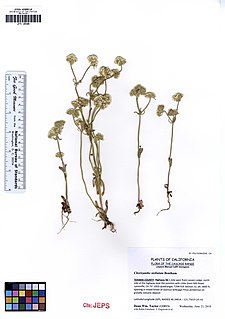
Chorizanthe stellulata is a species of flowering plant in the buckwheat family known by the common name starlet spineflower. It is endemic to California, where it grows in the dry woodlands of the low mountains and foothills along the central part of the state, such as the Sierra Nevada foothills. The plant takes an erect form, reaching up to 30 centimeters tall. The leaves are located at the base of the plant, and there is also a whorl of leaves at mid-stem. The inflorescence is a dense cluster of flowers, each flower surrounded by hairy, bristly white bracts tipped with hooked awns. The flower is 4 or 5 millimeters long and white to pink in color.
Chorizanthe uniaristata is a species of flowering plant in the buckwheat family known by the common name one-awn spineflower. It is endemic to central California, where it is known from several of the local mountain ranges, as well as the Central Coast.
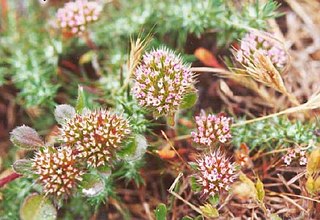
Chorizanthe valida is a rare species of flowering plant in the buckwheat family known by the common name Sonoma spineflower. It is endemic to West Marin, Marin County, California, where it is known from only one remaining natural population at Point Reyes National Seashore. It was thought to be extinct until 1980 when the Point Reyes population was discovered.
Chorizanthe wheeleri is a rare species of flowering plant in the buckwheat family known by the common names Santa Barbara spineflower and Wheeler's spineflower. It is endemic to Santa Cruz and Santa Rosa Islands, two of the Channel Islands of California.









